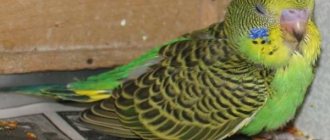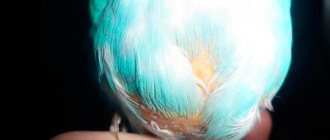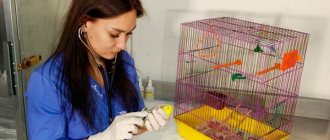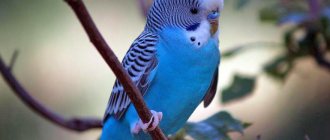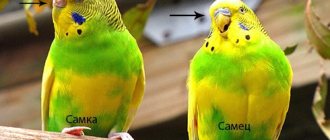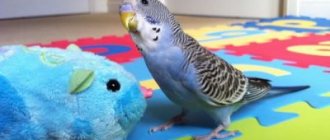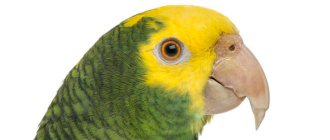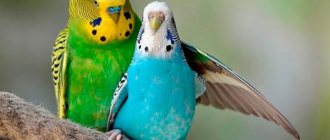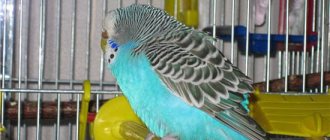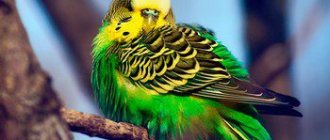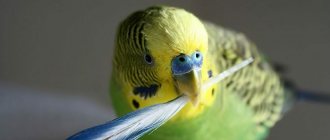One very famous joke says: “If all people could fly like birds, there would be traffic jams in the sky.”
The magic of flight is an amazing and alluring thing that we can only dream about.
The same cannot be said about our beloved parrots, because this art is given to them easily and not under pressure.
To verify this, you just need to let your feathered pet out of the cage.
But what happens if your parrot, by some coincidence, injures a wing and loses this opportunity?
First of all, in addition to possible painful shock, the bird will experience severe nervous stress.
All natural instincts will tell the parrot that it is now absolutely defenseless against any threat, because there is no way to fly away.
To get into such a difficult situation, the wing does not necessarily need to be broken, you can injure a joint, or simply pinch a nerve.
The owner of the parrot will experience no less stress, because how can one remain calm while watching this majestic bird suffer.
And since parrots are very active birds, situations like this happen quite often.
In this article we will try to consider the causes of such injuries, as well as ways to avoid them. Read and memorize.
- How dangerous can this be?
- What to do if your parrot breaks its wing
- Life after the fracture
What causes injuries?
Most often, ornamental birds have damaged paws. A parrot's wing can be injured if it gets stuck between the bars of the cage or pinched by something, as well as if it lands unsuccessfully or simply falls. Sometimes this condition occurs as a result of a person’s careless handling of the pet, playing with children, or excessive squeezing of the bird in the hand.
If a bird has hypovitaminosis, a lack of calcium in the body due to poor nutrition or due to diseases, tumors or inflammation in the skeletal system, it can also break its wings. In this case, consultation with a veterinarian is required to determine the cause of frequent injuries, treatment with medications, and diet correction.
The following are also injured: a parrot with poor coordination of movements due to damage to the nervous system, an inexperienced chick during the first molt.
Parrot safety
First, it is the parrot owner's job to ensure the safety of the parrot in its cage. The cage should not be cramped. The distance between the rods should be such that the parrot cannot stick its head between them. Sometimes the birds panic, and then they begin to fight in the cage. This could cause injury to your pet, so make sure there are no sharp objects or edges inside the cage.
In order for your bird to have a full life, it is recommended to let it out of its cage to fly. The owner’s task is to eliminate possible dangers. The curtains, at least on the first flights, should be moved. Glass doors and mirrors need to be curtained, otherwise the parrot may fly into them with all its might. Tall vases need to be covered - the bird may slip inside and get hurt.
Remember that while your bird is walking freely, you should not make sudden movements, scream loudly, shake the blankets, etc. – the parrot, frightened, will begin to rush about, and this can lead to injury.
Be careful and careful, take care of your bird!
Share with your friends:
Symptoms and signs
Dislocations
There are two types of dislocations: complete and incomplete. With the latter, the articular surfaces of the bones partially retain their connection with each other. The first option is more serious and sometimes requires surgical intervention.
14/4 There's something wrong with the parrot's wing. The female's wing hangs from sitting in the nest for a long time
A dislocated joint is manifested by symptoms such as:
- unnatural position of the limb, unusual bend angle;
- blue paws, swelling in this area;
- worried behavior of the bird;
- the wing trembles, movements in it are difficult.
Fractures
Even if you did not witness the moment your pet was injured, the following signs will help you understand that it has broken its wing:
- loss of the ability to fly;
- movements in the limb are limited;
- at the site of injury there is abnormal mobility, crunching, swelling;
- deformation or sagging of the wing (not always);
- the presence of a wound with bone fragments in an open fracture.
Already when observing the first two symptoms, it is advisable to immediately contact a veterinary clinic and get an x-ray.
Wing fracture in a parrot
How to understand that a parrot is injured
The easiest way to determine if your parrot has health problems is to monitor its behavior. If the bird eats, behaves and looks without deviations from daily behavior, then nothing is bothering it, but as soon as you notice any deviation, try to take appropriate measures as quickly as possible to normalize the situation.
The following factors will confirm that the parrot is injured:
- loss of balance when sitting on a perch or in flight;
- multi-level arrangement of wings - one may be shorter than the other;
- the bird's head falling to the side (it just can't keep it straight);
- unnatural position of one or two legs at once, which leads to lameness or the limb being pulled under itself;
- bruises, hematomas or abrasions on the body of the bird, sometimes with baldness of a separate area.
The limited mobility of a usually lively parrot is a serious reason to examine it more carefully.
You can notice a beak fracture visually by looking closely at its surface (often it appears asymmetrical and curved), and refusal to eat will confirm the presence of such a problem. Approximately the same can be said about a wing fracture, except that the birds refuse food only at first, but ignore the possibility of flying out of the cage for many days after the injury.
Severity and danger of a wing fracture
The skeleton of birds is “conceived” by nature to be light enough so that they can fly. But bird bones pay for this quality with their fragility. External impact of even a small impact force leads to fractures or dislocations. Thanks to accelerated metabolism, fusion and healing of damaged structures occurs quickly, but often incorrectly. As a result, the functionality of the limb is lost.
If a parrot's wing is injured, without human intervention and treatment, it may permanently lose the ability to fly. If the fracture is open, bone fragments damage surrounding tissue, causing bleeding. This situation is becoming life-threatening. In addition, the pet experiences severe pain at the time of injury and when moving the limb, it can die from shock.
Causes of injuries in parrots
The most common injuries to parrots include damage to the wings, beak or legs, the main causes of which often lie in the owner’s carelessness and violation of the conditions of keeping the birds.
Typically these statements include the following factors:
- frequent stay of the parrot outside the cage, which gives the bird access to a variety of, sometimes quite dangerous, objects in the room: uncurtained windows, furniture and any mirror surfaces that can seriously injure any parrot (the reflection of objects disorients the birds);
- keeping parrots in large groups in a limited space (by flapping their wings, individuals can collide with them, causing harm to each other);
- close proximity to domestic cats and dogs, which significantly increases the likelihood of mechanical damage as a result of bites or scratches;
- a sudden movement of the door (frame) on which the parrot was sitting (sometimes causes a fracture of the tubular parts of the legs);
- claws getting stuck in window curtains or owners’ clothes (when the bird tries to suddenly free itself from captivity, dislocated fingers may be observed);
- close contact with small children who are unable to correctly calculate their strength, which causes temporary suffocation or even death of the bird (sometimes, without parental control, children pull out the feathers of their pets, thereby causing bleeding);
- getting injured when “interacting” with mirrors, hooks and boxes, as a result of which abrasions, bruises and even open wounds can appear on the body, which are considered the most dangerous on this list, since bleeding in birds is characterized by duration (especially true for large birds like cockatoos , Gray or cockatiel).
Did you know? Like people, parrots are both right-handed and left-handed. To determine your pet's specific paw, observe which paw he takes food or tries to open the cage door with.
First aid
Examine the bird carefully to determine the nature of the injury. With an open fracture, a wound is visible from which bone fragments protrude. Otherwise it is closed. In case of severe bleeding, apply a tight bandage moistened with a 3% hydrogen peroxide solution to the damaged area and immediately show your pet to a doctor. Delay may result in the death of the parrot.
Wing fixation
Before painful procedures, feed your pet well and let it calm down. It is advisable to show it to a specialist who will administer anesthesia and prescribe treatment.
If your feathered friend is in a state of shock, rushes about, and does not give in to your hands, put a cut-off sock on him. Insert your head into one hole, fix the other over the wound for further manipulations.
If the joint is displaced, it is enough to apply a bandage for one or two days to support the wing until complete healing. If there is a fracture, you should immediately apply a splint to the damaged area.
Correct application of the splint
This is a necessary measure to limit movement in the limb. After all, they not only cause severe pain, but also lead to further aggravation of the injury. By fixing the displaced ends of the bones relative to each other, you will achieve their fusion and restoration of lost function.
The Bird Broke its Wing, What to Do // Wing Injury in Parrots // BIO-VET Veterinary Clinic Network
The correct execution of the procedure determines whether the parrot will be able to fly again. Therefore, it is better to immediately entrust his treatment to a veterinarian. If this cannot be done quickly, follow these recommendations:
- After providing first aid, prepare everything you need for further manipulations:
- disinfectant;
- sterile bandages;
- miniature scissors;
- thick cardboard;
- towel;
- adhesive plaster cut into thin strips;
- tweezers;
- textile.
- If there is an open wound, clean it of feathers and foreign objects. Disinfect with hydrogen peroxide, miramistine or chlorhexidine, but not with alcohol. Carefully move the protruding bones back into place and bring the edges of the skin together.
- For an open fracture, the splint is applied on both sides, and for a closed fracture, on one side. Adjust the size according to the healthy wing.
- Place gauze or a bandage under the splint, make it tight, and secure it with an adhesive plaster. You can also use it to pre-strengthen the cardboard so that it doesn’t get soggy.
Problems with a parrot's wing |
Poor Lyme When several days have already passed since the injury, it is unlikely that it will be possible to compare the bones. Therefore, you should contact a bird clinic.
How dangerous can this be?
Exactly as serious as the injury. One thing is for sure - situations where a wing injury occurs calmly and unnoticed simply do not exist.
A parrot is in the worst position when it is broken; this is very easy to notice if you look closely at the wings - the broken one will always be located below the healthy one.
Then there are two possible options:
- Apply a splint if everything is not too bad. The main thing to remember is that you need to know how to apply a splint, and therefore it is better to entrust this task to a professional, but even in this case, misfires are possible.
- Operation if everything is really bad and the upper part of the wing, or its middle, is damaged. It is true that it is worth noting that this operation is done quite quickly and not difficult.
The most severe case is a joint fracture. Complications are possible here if the joint heals incorrectly.
In any of these cases, there is one very important nuance - a very fast metabolism in parrots.
The body begins to heal wounds almost immediately as soon as they are received.
Therefore, you must immediately contact a specialist, otherwise the wing may not heal properly and serious surgery will be required.
And if the days count down, then she may no longer help, the bones will grow together very simply and even surgically changing their location will not be possible.
You will have to use anesthesia, separate the bones and apply a splint. All this will result in unnecessary expenses and worries for you and your pet.
Further actions
After providing assistance, place the parrot in a small cage without perches. Make the drinking bowl and feeder as accessible to him as possible. Provide your pet with peace, remove external stimuli so that the bird does not get scared and does not have the desire to fly away.
Nutrition should be complete. Add more foods containing calcium, vitamins, and your pet’s favorite treats to the diet. Do not let him walk around the room until he is completely recovered. Talk to your parrot more often, pay more attention.
The fusion of bones in small species of birds occurs within two weeks, in large species it takes up to one and a half months. If a nerve is affected, the process may be delayed.
Lipoma on the wings
This benign tumor most often appears in the area of the wings, chest, and shoulders. It can occur as a result of the growth of subcutaneous fat due to a sedentary lifestyle, a tendency to obesity, poor nutrition and maintenance. In budgies, the tumor is not operated on, but only supported with medication in order to stop the increase in volume.
Lipoma is a small, spherical, yellow swelling, soft to the touch. In the early stages it is difficult to notice under the feathers, so you should constantly pay due attention to your pet. If the tumor has formed on the wings, then the parrot may first refuse to fly, although otherwise it does not show any changes in lifestyle or appetite. In the absence of proper treatment, the lipoma grows, which complicates the life of the bird, and sometimes leads to its death. A parrot with lipoma should be regularly examined by an ornithologist to select the most appropriate treatment aimed at stopping its growth.
Unfortunately, this disease is very common in budgies. The earlier the formation is detected and treatment started, the more comforting the prognosis and the greater the likelihood of preserving all the functions of the wings.

